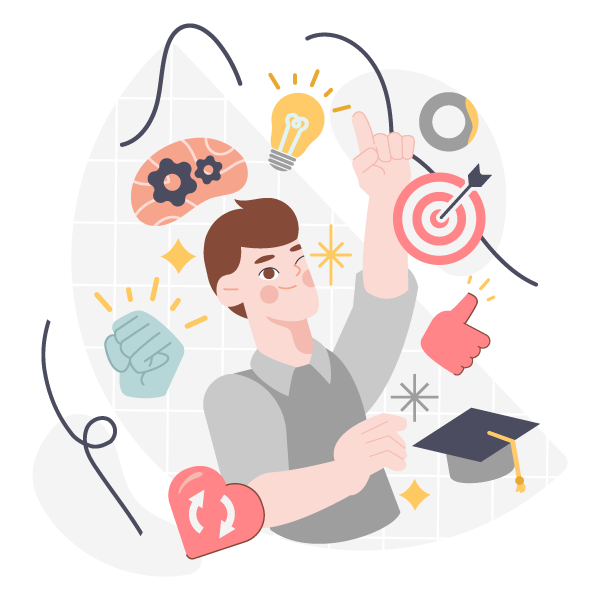Design. Thinking. Learning. What comes to mind when you visualize those three words?
For us, it’s a valuable educational model that guides and informs our process for most of our projects. Design thinking in learning helps reframe any problem or project in a human-centric way. By putting real people, real emotions, and real connection at the heart of learning and development, design thinking in eLearning gives us the right steps toward true mastery. It’s not the only educational model, but chances are that it could be the one your learning and development goals have been missing.
Get to know why we love design thinking and how it works to encourage learners to experiment and connect.
What Makes Design Thinking Unique?
There are three main educational models when it comes to creating new content and learning opportunities. The first is project-based: It’s when learners are asked to engage with material in order to meet a certain project-centric goal. It relies heavily on checkpoints and analytics to prove learners’ proficiency in solving a problem or completing a task.
The second model is understanding by design, which is best described as first isolating a problem and then working backward to find the right solution for L&D. While this model seeks to find the right content and delivery, it still relies on organizational goals that must be met and simply works to create the most efficient way to mastery or understanding.
While both of these models have their pros and cons, we know that we can do better by our learners. Putting the learner first creates superior opportunities to educate in a meaningful way. This is especially important when tackling more nuanced training topics like teamwork or resilience. When removing the hard-and-fast checkpoints and replacing them with an individual approach, we find that learners are more likely to experience real growth.
The human-centric approach to learning
Design thinking is a completely unique model in that it puts human emotion as the very first step to creating a solution. It can best be defined as exploration-based learning, where learners are encouraged to utilize real-world processes to find, test, and retest their solutions.
For us, the design thinking process starts with empathy. By first empathizing with the potential learner, it allows us to become much more flexible in not only the content and delivery, but the end goal as well. By acknowledging that comprehension might require more than just a score on a test or completing a course, we can better set personalized objectives that give us more flexibility in the L&D design process.
Should you implement design thinking into your learning strategy?
When you’re used to creating training experiences around specific project goals, making the switch to design thinking in learning can be tricky. If your organization has always done project-based training, putting the learner in the driver’s seat might seem like you’re giving up control of your L&D. And the thing is, you are: for good reason. Implementing design thinking into your eLearning strategy encourages learners to create their own solutions, challenge their own assumptions, and approach L&D as an evolutionary process. Because of this, it’s less of a race to the finish line and more an impactful experience where learners get to practice, create, and innovate their own path to success.
Design thinking works best when there is clearly more than one pathway to solving a problem. Rather than being led down one perfect path, learners quickly find that they can create their own solutions by brainstorming ideas, testing, failing, and trying again. It is meant to mimic the way we make real-life decisions. After all, rarely is the right answer presented on a platter. Instead, we think; we empathize; we try; we fail; and eventually, we succeed based on our own goals and ideals.
When creating learning for complex topics that aren’t easily defined by one answer or one discipline, design thinking allows us to broaden the way we approach any particular problem. It encourages critical thought and on-demand reactions to ideas. That’s why we love utilizing it as a model when training centers on topics that don’t necessarily require formal training, but abstract thought, discussion, and collaboration.
Benefits of implementing design thinking
The idea of design thinking in eLearning makes some uncomfortable because it really only works as hard as the learners. If you’re merely seeking to check an item off a list, it’s probably not going to be as effective as one of the other educational models. If you are, however, hoping to inspire your learners to find real interest and connection, the courage to move to design thinking can pay off in huge and sometimes surprising ways. Here are some of the benefits we routinely see when implementing design thinking as a learning strategy:
How does design thinking work
It’s no secret that, at ELM, we’re big fans of design thinking. If we’ve convinced you that it’s a superior educational model for planning an upcoming training project, the next step is understanding how to make design thinking work for your eLearning objectives. It’s a five-step process that can be completed and repeated as often as your learners want. Because it’s collaborative, creative, and empathetic, there’s really no finish line. The goal is growth and development, and that never ends. Instead, the cycle of design thinking simply restarts with a new problem to solve. Here’s how it works.
Empathize
If you’re serious about using design thinking for leading and learning, the cycle begins with empathy. You might also consider this stage of the cycle “research,” but it really boils down to tapping into the thoughts and feelings of others. It requires learners to think about the end user, which may or may not be themselves. This stage often utilizes current data to get a clear picture on potential issues so they can be defined and isolated before considering possible solutions.
Of course, while hard data is helpful, never underestimate the power of simply asking for input. By interviewing or polling end users, you might find the pieces that have been missing from past problem-solving puzzles. Gathering information on a personal level makes the synthesizing the problem a job for both the hearts and minds of those involved.
Define the problem
Once you have a better grasp on the end users’ perspective, you can begin to use that insight to define the problem before designing a solution. Defining the problem starts with interpreting the information you’ve gathered through the discovery process and puts it to work with practical applications. Defining the problem typically works best if you assign it a measurable goal. That way, you not only define the problem, but outline how you’ll know once the problem is adequately solved. In most cases, you’ll see the problem take shape during the empathy stage, and it should feel like a natural “next step” in the process.
Ideate
It’s time to start brainstorming! The ideation stage is an all-hands-on-deck, collaborative part of the design thinking model which generates a variety of solutions for the defined problem. When it comes to ideation, you’re looking for a wide spectrum of solutions, so don’t shoot any idea down right away. Instead, encourage input, and remind learners that all ideas are welcome during this stage. Some choose to track ideas in low-tech ways like sticky notes and sketchpads, but you can use mind-mapping, chat on Slack, or use whatever tools get the creative juices flowing and get your team talking.
Prototype
It might sound serious, but the prototyping phase simply means testing your solutions. It’s an experimental approach where solutions are applied and evaluated to decide whether they solve the problem or not. In the design thinking approach to training, the prototyping phase doesn’t require perfect solutions, but quick tests of mock-ups or implementation that give you immediate data to use and apply. Solutions will fail, but it’s always better to know they failed earlier and before significant time and effort was spent.
Test
Once you have a few working prototypes for your solution, it’s time to test and evaluate. Your end user is probably your most valued player when it comes to testing. As always, asking for feedback is one of the best ways to evaluate prototypes; make sure that the collaboration and input you encouraged earlier in the process continues strong as learners test their ideas. Once you’ve tested, you can regroup and talk about what worked, what didn’t, and how you could improve on your solution. This phase of the process can be used again and again to refine a solution that satisfies your end user and any other stakeholders in their roles.
Design thinking is eLearning
We utilize design thinking as an approach for creating eLearning, but it can exist as a learning process in and of itself. When you encourage your learners to think more empathetically, create more intentionally, and challenge their assumptions through testing, they go beyond simply memorizing information or completing a task. Design thinking encourages all to come up with impactful solutions based on real-world problems and goals.
The result? Learners who feel completely in control of their experience and know that their creative, on-demand solutions are valued and implemented. In short, putting humans first initiates smarter, more beautiful, more empathetic eLearning for everyone involved, and that’s the true spirit of design thinking.






